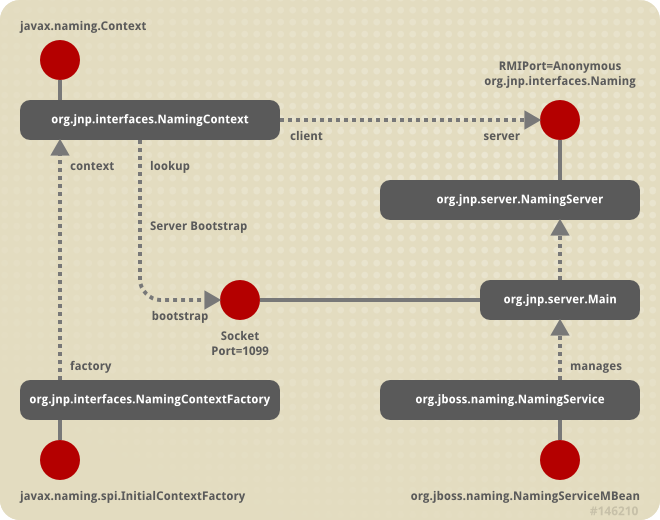9.2. The JBoss Naming Service Architecture
The JBoss Naming Service (JBossNS) architecture is a Java socket/RMI based implementation of the
javax.naming.Context interface. It is a client/server implementation that can be accessed remotely. The implementation is optimized so that access from within the same VM in which the JBossNS server is running does not involve sockets. Same VM access occurs through an object reference available as a global singleton. Figure 9.1, “Key components in the JBoss Naming Service architecture.” illustrates some of the key classes in the JBossNS implementation and their relationships.

Figure 9.1. Key components in the JBoss Naming Service architecture.
We will start with the
NamingService MBean. The NamingService MBean provides the JNDI naming service. This is a key service used pervasively by the J2EE technology components. The configurable attributes for the NamingService are as follows.
- Port: The jnp protocol listening port for the
NamingService. If not specified default is 1099, the same as the RMI registry default port. - RmiPort: The RMI port on which the RMI Naming implementation will be exported. If not specified the default is 0 which means use any available port.
- BindAddress: The specific address the
NamingServicelistens on. This can be used on a multi-homed host for ajava.net.ServerSocketthat will only accept connect requests on one of its addresses. - RmiBindAddress: The specific address the RMI server portion of the
NamingServicelistens on. This can be used on a multi-homed host for ajava.net.ServerSocketthat will only accept connect requests on one of its addresses. If this is not specified and theBindAddressis, theRmiBindAddressdefaults to theBindAddressvalue. - Backlog: The maximum queue length for incoming connection indications (a request to connect) is set to the
backlogparameter. If a connection indication arrives when the queue is full, the connection is refused. - ClientSocketFactory: An optional custom
java.rmi.server.RMIClientSocketFactoryimplementation class name. If not specified the defaultRMIClientSocketFactoryis used. - ServerSocketFactory: An optional custom
java.rmi.server.RMIServerSocketFactoryimplementation class name. If not specified the defaultRMIServerSocketFactoryis used. - JNPServerSocketFactory: An optional custom
javax.net.ServerSocketFactoryimplementation class name. This is the factory for theServerSocketused to bootstrap the download of the JBoss Naming ServiceNaminginterface. If not specified thejavax.net.ServerSocketFactory.getDefault()method value is used.
The
NamingService also creates the java:comp context such that access to this context is isolated based on the context class loader of the thread that accesses the java:comp context. This provides the application component private ENC that is required by the J2EE specs. This segregation is accomplished by binding a javax.naming.Reference to a context that uses the org.jboss.naming.ENCFactory as its javax.naming.ObjectFactory. When a client performs a lookup of java:comp, or any subcontext, the ENCFactory checks the thread context ClassLoader, and performs a lookup into a map using the ClassLoader as the key.
If a context instance does not exist for the class loader instance, one is created and associated with that class loader in the
ENCFactory map. Thus, correct isolation of an application component's ENC relies on each component receiving a unique ClassLoader that is associated with the component threads of execution.
The
NamingService delegates its functionality to an org.jnp.server.Main MBean. The reason for the duplicate MBeans is because JBoss Naming Service started out as a stand-alone JNDI implementation, and can still be run as such. The NamingService MBean embeds the Main instance into the server so that usage of JNDI with the same VM as the server does not incur any socket overhead. The configurable attributes of the NamingService are really the configurable attributes of the JBoss Naming Service Main MBean. The setting of any attributes on the NamingService MBean simply set the corresponding attributes on the Main MBean the NamingService contains. When the NamingService is started, it starts the contained Main MBean to activate the JNDI naming service.
In addition, the
NamingService exposes the Naming interface operations through a JMX detyped invoke operation. This allows the naming service to be accessed via JMX adaptors for arbitrary protocols. We will look at an example of how HTTP can be used to access the naming service using the invoke operation later in this chapter.
When the
Main MBean is started, it performs the following tasks:
- Instantiates an
org.jnp.naming.NamingServiceinstance and sets this as the local VM server instance. This is used by anyorg.jnp.interfaces.NamingContextinstances that are created within the server VM to avoid RMI calls over TCP/IP. - Exports the
NamingServerinstance'sorg.jnp.naming.interfaces.NamingRMI interface using the configuredRmiPort,ClientSocketFactory,ServerSocketFactoryattributes. - Creates a socket that listens on the interface given by the
BindAddressandPortattributes. - Spawns a thread to accept connections on the socket.

